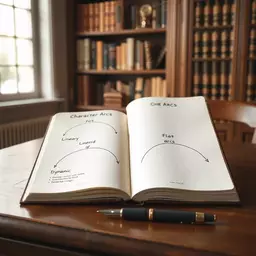Character Arcs Explained Simply
By Clara Eastwood / Nov 11
Character arcs are the emotional lifeblood of storytelling, shaping the journey of characters and enhancing reader engagement. Each arc serves as a unique blueprint that drives not just plot progression but also reader investment. Whether you're crafting a complex protagonist or a straightforward antagonist, understanding character arcs can elevate your writing to new heights.
Understanding the essential components of a character arc helps writers create compelling narratives. Below is a visual representation of these elements:
Where the character starts at the beginning of the story.
The obstacles they face that push them to grow.
How these challenges change the character over time.
Where the character ends up by the story's conclusion.
As a writer, I can't emphasize enough how crucial character arcs are to storytelling! They act as the backbone of your narrative, guiding your characters through remarkable journeys of change. Understanding character arcs helps you create engaging stories that resonate with readers and keep them turning the pages. For deeper insights, learn more about starting your first novel and finding the right narrative tools.
So, what exactly are character arcs? In simple terms, a character arc is the transformation a character undergoes throughout a story. This transformation can be physical, emotional, or moral, and it significantly shapes the overall narrative. It’s about how characters evolve in response to the challenges they face, ultimately leading to growth or decline.
Character arcs are vital because they provide your story with emotional depth. When readers witness a character's struggles and triumphs, they feel more connected to the story. Therefore, ensuring that your characters have compelling arcs can enhance reader engagement and satisfaction!
At its heart, a character arc consists of four essential elements:
With these components in mind, you can effectively outline your character's journey and ensure it feels authentic and impactful. To gain a deeper understanding of how these elements work together, explore how to create compelling character arcs that resonate with readers.
Character arcs are intricately tied to the narrative structure of your story. They help to:
In my experience as an educator at Fiction Frameworks, I have found that writers who clearly map out their characters' arcs often create more cohesive and compelling stories. Embracing this structure not only helps in writing but also boosts your confidence in storytelling!
Character arcs come in various shapes and forms, each serving unique storytelling purposes. By understanding the different types, you can select which arc best fits your narrative! Let’s delve into the spectrum of character arcs:
Here's a brief recap of the key points discussed so far:
As we wrap up our exploration of character arcs, it’s essential to reflect on the vast landscape of storytelling they inhabit. Character arcs serve as the backbone of narrative structure, enriching plots and deepening reader engagement. By understanding the different types of arcs—positive, negative, flat, and transformational—we can appreciate how they contribute to a character's journey and their overall impact on the story.
When analyzing character arcs, utilizing diverse examples from various genres and cultures broadens our understanding significantly. This not only enhances our appreciation for the craft but also reveals the universal themes that resonate across different narratives. By integrating insights from international literature, we can uncover fresh perspectives on character development.
Incorporating a range of characters and stories can deepen our comprehension of character arcs. Here are some ways to think about this diversity:
By engaging with a variety of examples, we not only enrich our writing toolbox but also enhance our empathy and understanding of characters’ motivations and arcs. This is a fundamental aspect of what we aim for at Fiction Frameworks—to empower writers to craft compelling narratives. To further enhance your writing, consider using effective plotting tools to structure your stories seamlessly.
Different genres often require unique approaches to character arcs. For instance, a mystery novel may focus on the negative arc of a detective facing moral dilemmas, while a fantasy story might highlight a positive arc in the hero's journey. Here are a few genres to consider:
To truly master character arcs, it’s crucial to embrace various perspectives. By stepping into the shoes of diverse characters, we can create richer, more relatable stories. This commitment to diversity not only enhances our writing but also reflects the broad spectrum of human experiences. It's a mission that aligns with the ethos of Fiction Frameworks, where we strive to help every writer unlock their potential and embrace the complexity of character development.
Now that we've distilled the key takeaways, it's time to put this knowledge into action. Understanding character arcs is just the beginning; the real magic happens when you implement these insights in your own writing. Here are some practical steps to get started:
By actively engaging with character arcs, you can create more dynamic and relatable characters that resonate with your readers. Remember, character arcs are not just tools—they're the essence of storytelling! For assistance in structuring your narrative, explore how using templates for fiction writing can simplify your creative process.
Utilizing insights about character arcs effectively requires a thoughtful approach. Here are some tips you can employ:
Complex characters make for engaging stories, and exploring their arcs can lead to profound narratives. Challenge yourself to write outside your comfort zone! Create characters who defy typical arc patterns, perhaps by mixing elements of positive and negative arcs. This experimentation can yield fascinating results that elevate your storytelling.
As we wrap up, I invite you to share your experiences with character arcs in literature. What arcs have resonated with you? How have they influenced your writing? Engaging with others can provide valuable insights, so let's create a dialogue!
At Fiction Frameworks, we believe that community and sharing are vital to our growth as writers. Let’s keep the conversation going and support each other on our journeys! Discover more about how character arcs enhance storytelling depth in our other articles.
Here’s a concise recap of the essential points discussed in the article:

 Character Arcs Explained Simply
Every compelling story resonates with readers because of the evolution of its characters. Whether it
Character Arcs Explained Simply
Every compelling story resonates with readers because of the evolution of its characters. Whether it
 Outline Your Novel with Templates
Have you ever been stuck staring at a blank page, unsure of where to start? Outlining your novel can
Outline Your Novel with Templates
Have you ever been stuck staring at a blank page, unsure of where to start? Outlining your novel can
 Plotting Fiction: Strategies That Work
Did you know that a well-structured plot can make the difference between a reader putting your book
Plotting Fiction: Strategies That Work
Did you know that a well-structured plot can make the difference between a reader putting your book